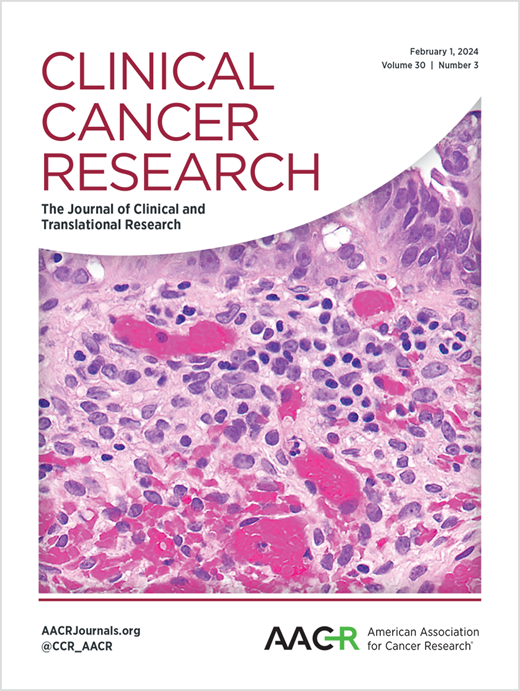The Impact of Concordance Between Liquid and Tissue Biopsy for Actionable Mutations: Insights from the Rome Trial
IF 10.2
1区 医学
Q1 ONCOLOGY
引用次数: 0
Abstract
Purpose: This analysis evaluated the influence of tissue and liquid biopsy concordance on outcomes in patients enrolled in the ROME Trial. Experimental design: The ROME trial, a phase II multicenter study, enrolled 1,794 patients with advanced solid tumors. Next-generation sequencing (NGS) was performed on tissue and liquid biopsies using FoundationOne CDx and FoundationOne Liquid CDx, A centralized Molecular Tumor Board (MTB) reviewed results to identify actionable alterations, with 400 patients randomized to tailored therapy (TT) or standard-of-care (SoC).TT improved objective response rate and progression-free survival (PFS) in the Intention to Treat population. Concordance was defined as the detection of the same druggable alteration in both biopsy types; discordance indicated detection in only one. Results: Concordance was present in 49% of cases, with alterations detected exclusively in tissue (35%) or liquid (16%) biopsies. Patients in the concordant group receiving TT experienced improved survival outcomes. Median overall survival (OS) was 11.05 vs. 7.70 months in the SoC group (HR 0.74; 95% CI: 0.51-1.07), and median PFS was 4.93 vs. 2.80 months (HR 0.55; 95% CI: 0.40-0.76). In contrast, the survival benefit of TT was less pronounced or absent in patients with discordant results. OS was higher in the T+L group (11.05 months), followed by tissue-only (9.93 months), and liquid-only groups (4.05months). PFS followed a similar pattern, with the longest PFS in T+L group (4.93 months) vs 3.06 months in tissue-only and 2.07 months in liquid-only groups. Conclusions: The study highlights the potential value of integrating both biopsy modalities in selected clinical contexts.液体和组织活检对可操作突变的一致性影响:来自罗马试验的见解
目的:本分析评估组织和液体活检一致性对纳入ROME试验的患者结局的影响。实验设计:ROME试验是一项II期多中心研究,纳入了1794例晚期实体瘤患者。使用FoundationOne CDx和FoundationOne liquid CDx对组织和液体活检进行下一代测序(NGS),一个集中的分子肿瘤委员会(MTB)审查结果以确定可操作的改变,400名患者随机接受量身定制治疗(TT)或标准护理(SoC)。TT改善了意向治疗人群的客观缓解率和无进展生存期(PFS)。一致性定义为在两种活检类型中检测到相同的可药物改变;不一致表明只有一个检测。结果:49%的病例存在一致性,仅在组织活检(35%)或液体活检(16%)中检测到改变。接受TT治疗的和谐组患者的生存结果有所改善。SoC组的中位总生存期(OS)为11.05 vs 7.70个月(HR 0.74; 95% CI: 0.51-1.07),中位PFS为4.93 vs 2.80个月(HR 0.55; 95% CI: 0.40-0.76)。相比之下,在结果不一致的患者中,TT的生存获益不太明显或不存在。T+L组的OS最高(11.05个月),其次是单纯组织组(9.93个月)和单纯液体组(4.05个月)。PFS也有类似的模式,T+L组PFS最长(4.93个月),而纯组织组为3.06个月,纯液体组为2.07个月。结论:该研究强调了在选定的临床背景下整合两种活检方式的潜在价值。
本文章由计算机程序翻译,如有差异,请以英文原文为准。
求助全文
约1分钟内获得全文
求助全文
来源期刊

Clinical Cancer Research
医学-肿瘤学
CiteScore
20.10
自引率
1.70%
发文量
1207
审稿时长
2.1 months
期刊介绍:
Clinical Cancer Research is a journal focusing on groundbreaking research in cancer, specifically in the areas where the laboratory and the clinic intersect. Our primary interest lies in clinical trials that investigate novel treatments, accompanied by research on pharmacology, molecular alterations, and biomarkers that can predict response or resistance to these treatments. Furthermore, we prioritize laboratory and animal studies that explore new drugs and targeted agents with the potential to advance to clinical trials. We also encourage research on targetable mechanisms of cancer development, progression, and metastasis.
 求助内容:
求助内容: 应助结果提醒方式:
应助结果提醒方式:


